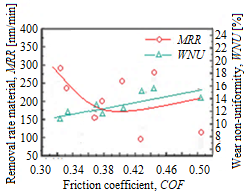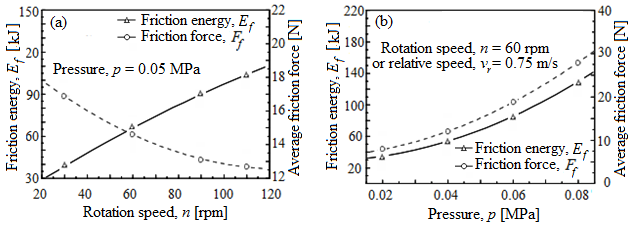Abstract: Chemical–mechanical planarization (CMP) represents the preferred technology in which both chemical and mechanical interactions are combined to achieve global planarization/polishing of wafer surfaces (wafer patterns from metal with a selective layer, in this paper). CMP is a complex process of material removal process by friction, which interferes with numerous mechanical and chemical parameters. Compared with chemical parameters, mechanical parameters have a greater influence on the material removal rate (MRR). The mechanical parameters manifest by friction force (Ff ) and heat generated by friction in the CMP process. The Ff can be estimated by its monitoring in the CMP process, and process temperature is obtained with help of an infrared rays (IR) sensor. Both the Ff and the MRR increase by introducing colloidal silica (SiO2 ) as an abrasive into the selective layer CMP slurry. The calculated wafer non-uniformity (WNU) was correlated with the friction coefficient (COF). The control of Ff and of the slurry stability is important to maintain a good quality of planarization with optimal results, because Ff participates in mechanical abrasion, and large Ff may generate defects on the wafer surface. Additionally, the temperature generated by the Ff increases as the SiO2 concentration increases. The MRR of the selective layer into the CMP slurry showed a non-linear (Prestonian) behavior, useful not only to improve the planarization level but to improve its non-uniformity due to the various pressure distributions. The evaluation of the Ff allowed the calculation of the friction energy (Ef ) to highlight the chemical contribution in selective-layer CMP, from which it derived an empirical model for the material removal amount (MRA) and validated by the CMP results. With the addition of abrasive nanoparticles into the CMP slurry, their concentration increased and the MRA of the selective layer improved; Ff and MRR can be increased due to the number of chemisorbed active abrasive nanoparticles by the selective layer. Therefore, a single abrasive was considered to better understand the effect of SiO2 concentration as an abrasive and of the MRR features depending on abrasive nanoparticle concentration. This paper highlights the correlation between friction and temperature of the SiO2 slurry with CMP results, useful to examine the temperature distribution. All the MRRs depending on Ef after planarization with various SiO2 concentrations had a non-linear characteristic. The obtained results can help in developing a CMP process more effectively.
Introduction
In a friction pair, a selective transfer can certainly be made if, in the contact area, there exists an adequate lubricant (such as glycerin), a copper-based material (in this case, bronze), relative movement, and favorable energy. By investigating the CMP process of the selective layer, in which copper was the predominant element (≥85%), it was found that under normal conditions, its surface is oxidized. The rates of oxide removal differ depending on the applied load, the removal depth, and the slurry used. There is extensive research on the CMP process, but for a better understanding of the mechanical and tribochemical phenomena, additional studies are needed that appear at the interface of the pad–wafer (selective layer) in the presence of fluid slurry. The studies carried out by Ilie and Lee et al. showed that the formation of an oxide film on the selective layer surface requires the use of an oxidizer. However, due to the volatile copper compounds that are formed only at high temperatures, dry etching on the selective layer surface is not practical.
Materials and Methods
The friction and thermal investigation in the CMP process on a selective-layer surface were carried out on a wafer pattern with a selective layer. The wafer pattern from metal was made of OLC45 steel, previously coated on one face with a selective layer (thickness of about 500 nm) by friction with the CuSn12T bronze .
Results and Discussion
Friction Characteristics in the CMP Process
The aim of the CMP process is to obtain the global planarization/ polishing of thesurfaces of the wafers (here covered with a selective layer), in which mechanical andchemical interactions are combined to achieve an efficient MRR. Mechanical interactionsare manifested by Fr and frictional heat in the CMP process. By introducing SiO, as anabrasive in the selectivelaver CMP slurry, both Fr and MRR increase, and the calculatedWNU is correlated with the COF. Additionally, the F, allows the calculation of the E, tofacilitate the representation of mechanical action/abrasion during the CMP process.
Thus, Figure 1 shows the variation of MRR and WNU depending on Er. As shownin Figure 1,Er is related in particular to the MRR, not to the WNU. It is observed as MRRincreases with the increasing Er. In the CMP process of the oxides, the input energy causedby the relative speed, the chemicals, and of contact is composed of energy, Er, thermal, Eand vibration, Ey. Among these components of energy, Er and Er participate at the MRRand E, is dispersed in the surrounding environment (15,16). According to Figure 1, theMRR is dependent on the Erin the CMP process; however, the MRR is related to Fr throughthe quantity removed per unit length.

Figure 1. Removal rate material (MRR) and wafer non-uniformity (WNU), depending on friction energy (Ef).
The factors that influence the WNU in the CMP process are largely divided into processing and equipment conditions, chemicals, and consumables. Therefore, the WNU depends on the CMP planarization mechanical characteristics in the work process if there are no changes in the consumables and the slurry composition. Experimentally, it turned out that there was a connection between the friction coefficient (COF) and the WNU. Thus, Figure 2 shows the evolution of the MRR and WNU depending on COF. The COF was introduced to characterize the friction effect and was determined by measuring Ff and establishing the resultant normal force during the CMP process. According to Figure 2, as the COF increases, the WNU also grows, due to the resultant normal force’s position. The resultant normal force is determined from the moment’s equilibrium equation relative to the planarization (polishing) head center, as it moves away from the planarization/polishing platen.

Figure 2. Variation of MRR and WNU depending on COF in the CMP process.
Figure 3 shows friction characteristics (friction energy, Er, and average friction forceF) with the change of rotational speed, n(ur), and pressure, p.

Figure 3. Variation friction characteristics (E and F) with the process parameters: (a) Er and averageFr depending on n(ur), at p constant; (b) Er and average Fr depending on p at n(or), constant.
Figure 3a shows the variation E and average F; with various rotating speeds atconstant pressure, p. While n(ur) increases, the Er also increases; however, the average Fdecreases because the removed amount per unit time is prolonged with an increase inn(u). Moreover, the decrease in F. with growing n(ur) also takes place due to the supportprovided by the boundary layer between the wafer and pad formed as a result of thesuspension flow via the pressure dynamic, p (16). Figure 3b shows the variation of Fr andEr with various p of planarization/polishing at an n(ur) constant. With the increase in pof planarization/polishing, both the Fr and Er grow due to the real contact area influencecaused by the p of planarization.
Thermal Effect in the CMP Process
The temperature generated by the friction to the pad–wafer contact in the CMP process is a critical parameter for the MRR. At the same time, this temperature is inevitable during the CMP process because it is provoked by Ff due to the abrasive nanoparticles and the CMP slurry chemistry. Therefore, Figure 4 illustrates how the CMP process friction characteristics are dependent on the material mechanical and chemical removal. Thus, the friction is caused the most by the abrasive nanoparticles in the CMP slurry, as seen in Figure 4a. Additionally, it is observed that the CMP process temperature, depending on the pressure, p (see Figure 4b), generated through de-ionized water, is bigger than that that generated through the slurry. The de-ionized water was used in the experiments to significantly highlight the effect (influence) of the abrasive nanoparticles in the slurry, as seen in Figure 4. Therefore, the process temperature also contributes to the MRR, which is caused by Ff in the CMP process.

Figure 4. Abrasive nanoparticle's effect on Fr and process temperature during the CMP process:(a) the friction force, F,, using planarization with de-ionized water; (b) process temperature during planarization with de-ionized water and with CMP slurry, depending on the pressure, p.
Conclusions
The frictional angthermal features of the selective-layer CMP process were analyzedin correlation with the MRR by the monitoring of Fr depending on SiO, concentration in anacid slurry mixed with an oxidizer, corrosion inhibitor, complexing agent, and surfactant.
The Ir can decrease by increasing the planarization pad rotating speed at a constantpressure, and the slurry boundary layer support formed between the wafer and padAdditionally, the Frcan increase due to modification of the real contact area with increasingpressure, and WNU calculated from the balance moments equation in ratio with theplanarization head center was in correlation with the COF.
Additionally, by reducing at a minimum the surface defects, with an optimal MRR, it can attain a quality planarization. This requirement can be met in the CMP process through abrasive nanoparticle stability and properties or by slurry chemistry engineering, respectively, by the control of the mechanical and chemical interactions.